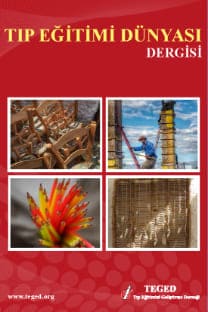Patoloji Eğitiminde Harmanlanmış Öğrenme Yaklaşımının Akademik Başarı ve Memnuniyet Üzerine Etkisi
Patoloji eğitimi, Sanal mikroskop, Harmanlanmış öğrenme, Dijital patoloji
The effect of the blended learning approach in pathology education on academic achievement and satisfaction
___
- Knollmann-Ritschel, B. E., Regula, D. P., Borowitz, M. J., Conran, R., & Prystowsky, M. B. (2017). Pathology competencies for medical education and educational cases. Academic pathology, 4, 2374289517715040.
- Maley, M. A., Harvey, J. R., Boer, W. B. D., Scott, N. W., & Arena, G. E. (2008). Addressing current problems in teaching pathology to medical students: blended learning. Medical teacher, 30(1), e1-e9.
- Sadofsky, M., Knollmann-Ritschel, B., Conran, R. M., & Prystowsky, M. B. (2014). National standards in pathology education: developing competencies for integrated medical school curricula. Archives of Pathology and Laboratory Medicine, 138(3), 328-332.
- Sağol, Ö., Yörükoğlu, K., Lebe, B., Durak, M. G., UlukuŞ, Ç., Tuna, B., ... & Özer, E. (2015). Transition to Virtual Microscopy in Medical Undergraduate Pathology Education: First Experience of Turkey in Dokuz Eylül University Hospital. Turkish Journal of Pathology, 31(3), 175-180
- Hamilton, P. W., Wang, Y., & McCullough, S. J. (2012). Virtual microscopy and digital pathology in training and education. Apmis, 120(4), 305-315.
- Dee, F. R., & Meyerholz, D. K. (2007). Teaching medical pathology in the twenty-first century: virtual microscopy applications. Journal of veterinary medical education, 34(4), 431-436.
- Carneiro, R., Lefrere, P., Steffens, K., & Underwood, J. (Eds.). (2012). Self-regulated learning in technology enhanced learning environments (Vol. 5). Springer Science & Business Media.
- Fermozelli, J. A., Cesaretti, M. L. R., & Barbo, M. L. P. (2017). Blended learning strategies in teaching general pathology at a medical course. Jornal Brasileiro de Patologia e Medicina Laboratorial, 53(3), 202-209.
- Horzum, M. B. (2011). Transaksiyonel uzaklık algısı ölçeğinin geliştirilmesi ve karma öğrenme öğrencilerinin transaksiyonel uzaklık algılarının çeşitli değişkenler açısından incelenmesi. Kuram ve Uygulamada Eğitim Bilimleri Dergisi, 11(3), 1571-1587.
- Ariana, A., Amin, M., Pakneshan, S., Dolan-Evans, E., & Lam, A. K. (2016). Integration of traditional and E-learning methods to improve learning outcomes for dental students in histopathology. Journal of dental education, 80(9), 1140-1148.
- Balaman, F., & Tüysüz, C. (2011). Harmanlanmış öğrenme modelinin 7. sınıf öğrencilerinin fen ve teknoloji dersindeki başarılarına, tutumlarına ve motivasyonlarına etkisinin incelenmesi. Batı Anadolu Eğitim Bilimleri Dergisi, 2(4), 75-90.
- Butler, D. L., & Winne, P. H. (1995). Feedback and self-regulated learning: A theoretical synthesis. Review of educational research, 65(3), 245-281.
- Winne, P. H., & Hadwin, A. F. (1998). Studying as self-regulated learning. In D. J. Hacker, J. Dunlosky, & A. C. Graesser (Eds.), The educational psychology series.
- Metacognition in educational theory and practice (pp. 277-304). Mahwah, NJ, US: Lawrence Erlbaum Associates Publishers.
- Camus, M., Hurt, N. E., Larson, L. R., & Prevost, L. (2016). Facebook as an online teaching tool: Effects on student participation, learning, and overall course performance. College Teaching, 64(2), 84-94.
- Wang, Q., Woo, H. L., Quek, C. L., Yang, Y., & Liu, M. (2012). Using the Facebook group as a learning management system: An exploratory study. British Journal of Educational Technology, 43(3), 428-438.
- ISSN: 1303-328X
- Yayın Aralığı: Yılda 3 Sayı
- Başlangıç: 2000
- Yayıncı: Tıp Eğitimini Geliştirme Derneği
Uzun Vaka Olarak Sinema Filmlerinin Kullanımına Bir Örnek: The Doctor
Müesser ÖZCAN, Edip Güvenç ÇEKİÇ, Ümmühani ÖZEL TÜRKCÜ, Hülya ELBE
Anatomi̇de Tahni̇t ve Di̇seksi̇yon Eği̇ti̇mi̇ İçi̇n Olası Bi̇r Kaynak: Sağlık Turizmi*
Patoloji Eğitiminde Harmanlanmış Öğrenme Yaklaşımının Akademik Başarı ve Memnuniyet Üzerine Etkisi
Arif ONAN, Alp USUBÜTÜN, Barış SEZER
Ulusal Çeki̇rdek Eği̇ti̇m Programı Ai̇le Heki̇mli̇ği̇ Prati̇ği̇ndeki̇ Sorunları Kapsıyor mu?
Aysel BAŞER, Giray KOLCU, Hatice ŞAHİN
İzmir Kâtip Çelebi Üniversitesi Tıp Fakültesi Organizasyon Şeması ve Optimizasyonu
Anatomi̇de Tahni̇t Ve Di̇seksi̇yon Eği̇ti̇mi̇ İçi̇n Olası Bi̇r Kaynak: Sağlık Turizmi
Epistemolojik İnanç Ölçeğinin Tıp Eğitimi Alanı İçin Geçerlik ve Güvenirlik Çalışması
Şeyda Ferah ARSLAN, Özlem SARIKAYA
Akıllı telefon kullanımının karanlık tarafı (Nomofobi): Endişelenmemize gerek var mı?
Barış SEZER, Bürge ATILGAN ÇİFTÇİ
Tıpta Uzmanlık Eğitimi ve Asistan Hekimlerin Sorunlarının İrdelenmesi: Bir Anket Çalışması
